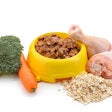In a new study conducted by the Swedish University of Agricultural Sciences and Aker BioMarine, scientists evaluated the performance of three different omega-3 sources in canine feeds. Of the three ingredients tested, the krill-based ingredient, QRILL Pet PL Nutri Plus (QRILL Pet’s flagship krill meal product), was most effective in raising the dogs’ Omega-3 Index.
This study builds on a previous feeding trial conducted in 2020 by Aker BioMarine, which showed that of the dogs fed either QRILL Pet PL Nutri Plus (8%) or fish oil, the QRILL Pet group exhibited the greatest improvements to their Omega-3 Index after six weeks. In this new trial, the researchers aimed to build a greater understanding of how krill meal, at a lower inclusion level, would perform in comparison to two other omega-3 sources, namely fish and flaxseed. All three providing similar amounts of omega-3 to the study diets.
“The hypothesis we tested was whether krill, at a lower inclusion level of just 3% on a dry matter (DM) basis, would be as or more effective in raising the dogs’ omega-3 levels than other ingredients when omega-3 content was similar. We believe that both the delivery molecule of omega-3 as well as the type of omega-3 in a diet matters. To understand this, we did a side-by-side comparison of EPA/DHA from krill with two other omega-3 sources (EPA/DHA from fish and alpha-linolenic acid from flaxseed) which both are commonly found in pet food today,” says scientist Hanna Lindqvist from Swedish University of Agricultural Sciences.
Four-week, three-arm trial tests three different omega-3 ingredients in the dog feed
Before launching the experiment, the omega-3 levels of the 45 participating Alaskan Huskies sled dogs were measured to establish a baseline. Researchers found that the Omega-3 Index for the dogs was at a low starting point (at 1.3% on average), a state that is not uncommon in pets, they report.
Over the next four weeks, the dogs received one of the three test feeds. The omega-3 ingredients were included in the raw food provided to the dogs twice daily. The trial was run during a low-training period for the dogs, meaning their dietary needs at the time were on par with the average active dog.
Key findings: Which omega-3 ingredient was most effective?
- Krill meal, in the form of QRILL Pet PL Nutri Plus, was most effective in raising the Omega-3 Index in the dogs–bringing it to an average of 2.4%.
- Fish meal was the second most effective source of omega-3, raising the Omega-3 Index to an average of 1.9%.
- Flaxseed (alpha-linolenic acid) had no significant effect on the dogs’ Omega-3 Index.
“What we learned from this trial was that not every omega-3 source performs equally, and that both the delivery molecule of the omega-3`s as well as type of omega-3 makes a difference. The phospholipid omega-3 in krill appears to be more effective than triglyceride omega-3 from fish or alpha-linolenic acid from flaxseed. There is an opportunity for commercial feeds to benefit from a more effective ingredient, and we found that even in lower doses, krill meal is still the most effective in terms of raising the Omega-3 Index in pets,” says Lindqvist.












